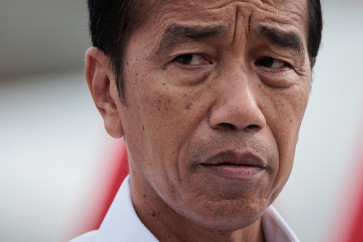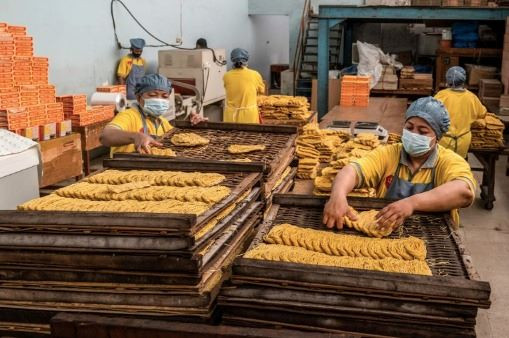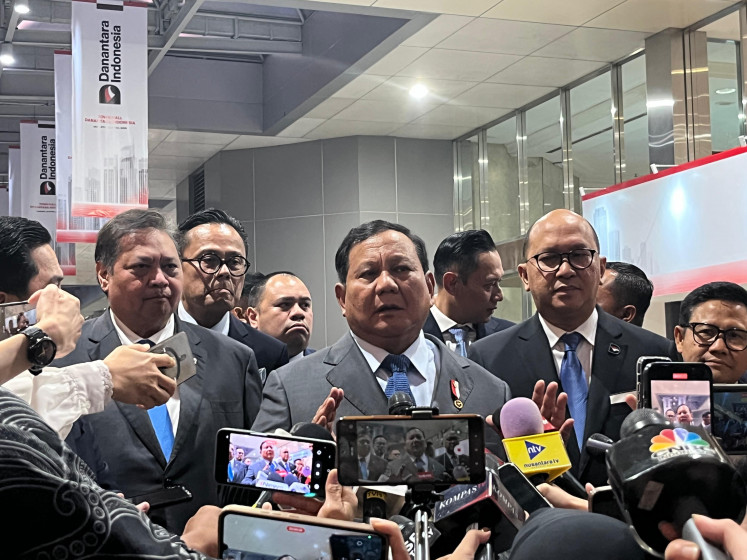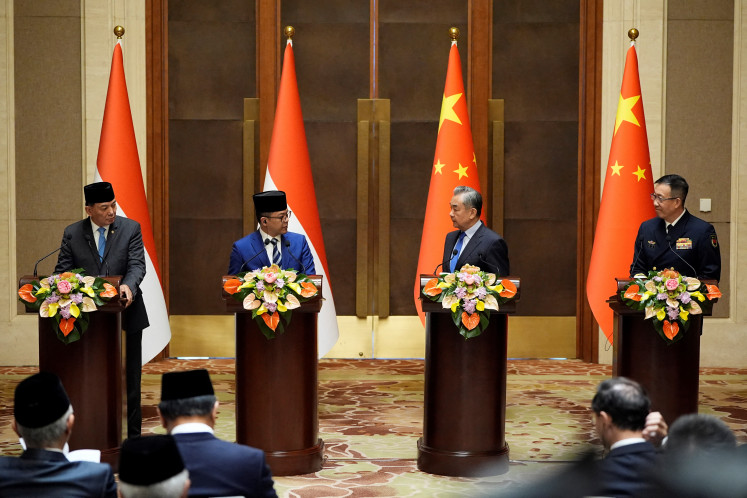Reducing regional price disparity
Price disparity among the regions is exceptionally high. For example, based on Information Center for Strategic Food Price ( PIHPS ) data, as of Sept. 14, onions in Jakarta sold for roughly Rp 41,250 (US$3.14) per kilogram but in West Papua they cost Rp 60,000 per kg. Similarly, chicken in Jakarta was about Rp 20,400 per kg but in West Papua it sold for Rp 30,050 per kg. The main reason for the high price disparity between the two regions is high logistics costs.
Change text size
Gift Premium Articles
to Anyone
 A crane moves a shipping container in the container pool of a seaport in Qingdao in eastern China's Shandong province, Oct. 13, 2015. (AP/*)
A crane moves a shipping container in the container pool of a seaport in Qingdao in eastern China's Shandong province, Oct. 13, 2015. (AP/*)
P
rice disparity among the regions is exceptionally high. For example, based on Information Center for Strategic Food Price (PIHPS) data, as of Sept. 14, onions in Jakarta sold for roughly Rp 41,250 (US$3.14) per kilogram but in West Papua they cost Rp 60,000 per kg. Similarly, chicken in Jakarta was about Rp 20,400 per kg but in West Papua it sold for Rp 30,050 per kg. The main reason for the high price disparity between the two regions is high logistics costs.
As an archipelagic country, shipping costs are one of the most important variables affecting commodity prices between the regions. Domestic shipping costs in Indonesia are much higher than international shipping costs. Based on World Bank data, shipping costs for a 6-meter container in Indonesian territories, for instance from Tanjung Priok to Jayapura, Tanjung Priok to Padang and Tanjung Priok to Banjarmasin are approximately $1,000, $600 and $650, respectively.
In comparison, shipping costs from Tanjung Priok to Guangzhou (China) and from Tanjung Priok to Singapore is around $400 and $185, respectively. Accordingly, domestic shipping costs in Indonesia are approximately three times higher than international shipping costs.
In addition, the costs of shipping in Indonesia is currently about 24 percent of the country’s gross domestic product (GDP), higher than in China (18 percent), Thailand (15 percent) and Singapore (8 percent), based on McKinsey data. According to the 2015-2019 National Mid-Term Development Plan, the Joko “Jokowi” Widodo government aims to reduce shipping costs to 19.2 percent of GDP by 2019.
The high price disparity between the eastern and western parts of Indonesia is largely caused by high freight costs. The reason is that almost all ships travel from the eastern to western regions without freight to transport, which also reflects the unbalanced flow of goods between these two regions. Note that the imbalance also indicates the disparity in regional economic development. In addition, the high price disparity is also due to a lack of port capacity in eastern Indonesia.
To date, most industries are concentrated in Java and products are therefore transported by fully loaded ships to the east. The problem is that the ships, on their return to the west, transport almost nothing. For example, based on 2014 Industry Ministry data, 50 industrial estates are located in Java (67.57 percent) and only 24 industrial estates are located outside Java (32.43 percent).
To reduce the price disparity, the government has introduced the “maritime highway” program. The Transportation Ministry estimates that if the sea highways were fully operated, staple food prices could drop by up to 30 percent in the eastern region.
The maritime highway program is designed to build a strategic infrastructure network and increase maritime connectivity. It needs a large amount of investment, approximately Rp 699 trillion from 2015 to 2019. The program will see large ships travel every day between the western and eastern parts of the country.
The government also plans to develop 24 seaports to support the program and to upgrade deep sea ports. Most of the seaports are located in the eastern region, such as in Bitung in North Sulawesi (as an international hub port), Makassar in South Sulawesi and Sorong in Papua (as a hub or main port). In the western region, the seaports are Kuala Tanjung and Belawan in North Sumatra, Batam in Riau Island, Tanjung Priok in Jakarta and Tanjung Perak in Surabaya. Sixteen other ports as spoke ports are both in the eastern and western regions.
In our view, the maritime highway program should be accompanied by policies to encourage the development of industry and production in the eastern region. It is clear that the price disparity between the western and eastern regions is due to high sea transportation costs between those regions, which are in turn caused by empty ships traveling from the eastern to the western region. Therefore, we should also stimulate the production side, such as industrial estate development in the eastern region. The production can subsequently be shipped to the western region, making trade flow between the western and eastern regions more balanced.
Supporting policies and adequate incentives are absolutely required for new investments coming into potential sectors in the eastern region. The development of industrial estates in this region should be promoted to help local resources flourish in the eastern region. For example, West Sulawesi, which has a potential natural resources-based industry, could develop the manufacturing of cocoa and its derivatives. Similarly, Central Sulawesi, which has a potential maritime resources-based industry, could grow seaweed products for manufacturing.
We believe that the maritime highway program should have a greater objective, not only as an effort to reduce shipping costs but also to develop an efficient logistics system together with other land transportation and warehousing.
So far, we do not feel that the government has a clear aim with a comprehensive program to integrate the maritime highway program with land transportation and warehousing development, including
integration with regional development. The maritime highway’s focus on shipping cost reduction is not sufficient to reduce regional price disparities.
Based on McKinsey data, about 70 percent of warehouses in Indonesia are below standard, in that they have, for example, inadequate facilities, security and supporting infrastructure. For example, in Makassar 70 percent of warehouses rely on old supporting infrastructure. Similarly, in Balikpapan, East Kalimantan, 80 percent of warehouses lack standard facilities and have poor connectivity.
In addition, land transportation in each region should also be upgraded. According to McKinsey Indonesia Maritime Strategy Reform Report in 2013, land transportation costs in Indonesia, at 8 percent of total GDP, are higher than in neighboring countries such as Thailand (5 percent of GDP) and Singapore (4 percent of GDP). Furthermore, land transportation performance, especially trucking, is still in poor condition because of inadequate road infrastructure. Goods in some areas in eastern Indonesia have to be transported by air, which is far more expensive.
Another effort to reduce regional price disparity is to take benefits from information and communication technology. Mobile phone technology could shorten the supply chain of goods that could reduce distribution fees. It could also make prices more competitive, since all producers and consumers would have better information to make the best decision for them. The National Task Force (POKJANAS) of the Regional Inflationary Control Team (TPID) has developed a website providing information concerning food prices in all provinces. Anyone can access this information, so this information dissemination could help reduce prices and price disparities among regions because of a more competitive market.
_____________
The writer is senior regional analyst at PT Bank Mandiri (Persero) Tbk.









